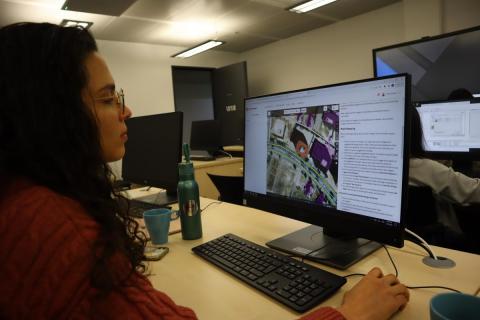
At the time of writing, the death toll of the February 6th earthquake in Turkey and Syria surpassed 46,000. The 7.8 magnitude earthquake hit southeastern Turkey and parts of Syria, devastating areas in both countries and shocking the world.
Within hours of the earthquake, global humanitarian organizations rushed to mobilize their resources to join in emergency response efforts. OSUN’s GeoHub project, a research collaboration between Central European University (CEU), American University of Central Asia (AUCA), and Bard College, joined the response initiative by rapidly coordinating a mapathon event at CEU and online on February 10th.
More than 100 participants across OSUN and beyond registered for the mapathon. Their combined efforts resulted in mapping more than 2,100 buildings and over 530 highways within the earthquake-affected areas. The results will help humanitarian organizations and disaster responders to channel their efforts more efficiently.
A mapathon is a coordinated digital event where the public is invited to make online map improvements in their local or international area to improve coverage and support disaster risk assessment and resource management activities. This particular event supported the Humanitarian OpenStreetMap Team (HOT) in the creation of openly accessible data for offline maps that could be used by emergency response teams.
GeoHub director Viktor Lagutov started the event by explaining how emergency OSM (OpenStreetMap) mapping can help disaster-affected communities around the world. Anastasia Kvasha, a researcher from CEU, then trained participants in OSM so they could create the valuable map data.
Lorant Czaran, attending from the United Nations Office for Outer Space Affairs (UNOOSA), unpacked how the global community can use events such as the mapathon to contribute more effectively to relief efforts on the ground.
“Every time a major disaster happens, the affected areas are not all that well mapped,” said Czaran. “It happened in Haiti, Pakistan, and Nepal; it happens everywhere. Now we are facing the situation where very heavily affected areas in Turkey and Syria are also not so well mapped, with not enough information on road networks and settlements.”
“Sadly, that’s the situation always, and that is why volunteer efforts, such as mapathons, are very important,” Czaran pointed out. "The new data added to open databases can be used by everybody, not only in the disaster response but also in all post-disaster, recovery, and reconstruction activities needed to build back better and be more prepared for the next time,” he explained.
Humanitarian organizations responding to natural disasters depend on geospatial data and maps to locate the most impacted areas, helping rescuers to efficiently coordinate evacuations, health support, and food and water deliveries to those in need. As network issues persist in the affected areas, offline maps with updated data are vital for supporting emergency actions. Additionally, maps can be a crucial part of damage assessments and monitoring long-term recovery after the immediate emergency.
While concerned individuals far from the scene of a crisis might feel powerless, participating in a mapathon is one practical way to enhance the effectiveness of crisis response efforts. All that is needed is a laptop and the desire to help. GeoHub will continue to organize such efforts, bringing global communities together so they can use their digital mapping skills for helping recovery and building resilience.
Volunteers can help map areas where humanitarian organizations are working to assist people at risk of disaster by supporting the Missing Maps project. They can also develop new skills using the resources available on the HOT Tasking Manager website. Follow the GeoHub page to find out about related upcoming activities.